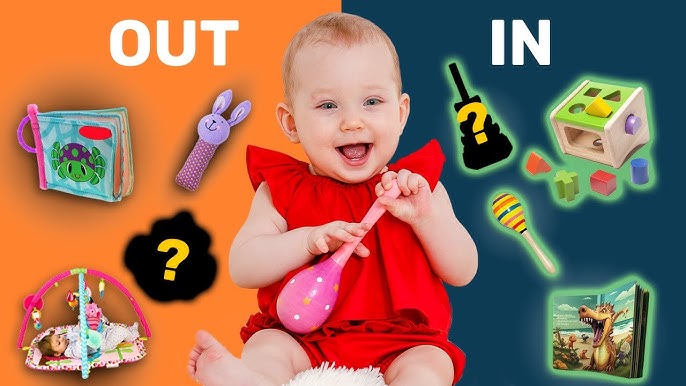Choosing toys for your baby can feel overwhelming. Walk into any baby store or browse online, and you’re instantly bombarded by countless options, each promising to be essential for your child’s development. But the wrong choices don’t just waste your hard-earned money—they could also hinder your baby’s growth or even pose safety risks. Luckily, knowing exactly which baby toys genuinely benefit your little one and which are a waste of money can simplify your decisions and ensure your purchases truly support healthy development.
The baby toys that are truly worth purchasing include those that enhance cognitive skills, sensory development, and physical coordination, such as shape sorters, stacking blocks, sensory toys, activity gyms, and soft interactive books. On the other hand, toys that are overpriced with excessive electronic features, loud noises, or small detachable parts are often unnecessary and can even be unsafe for your baby. Prioritizing simple, safe, and educational toys ensures you’re investing wisely.
Now that you understand the basic guidelines for distinguishing valuable baby toys from unnecessary ones, let’s dig deeper into specific questions you might have as your baby grows. After all, each stage of your baby’s development demands different toy choices. Keep reading to discover detailed insights into the types of toys that truly support your baby’s growth and safety, as well as those you should avoid.
What Types of Baby Toys Are Ideal for Cognitive Development?
Every parent worries about their baby’s cognitive development. With so many toys claiming to boost intelligence, it’s easy to feel overwhelmed and unsure whether you’re making the right choice. Selecting the wrong toys can result in missed developmental opportunities, causing unnecessary stress and confusion. Fortunately, there are clear, research-backed guidelines to help you choose toys that genuinely enhance your baby’s cognitive abilities.
The ideal baby toys for cognitive development are those that encourage problem-solving, creativity, and exploration. Examples include shape sorters, stacking blocks, simple puzzles, interactive fabric books, and toys with buttons and switches that prompt cause-and-effect learning. These toys stimulate curiosity, improve hand-eye coordination, and foster critical thinking, providing meaningful cognitive growth.
Are Expensive High-Tech Baby Toys Really Necessary?
Parents often assume that expensive, high-tech baby toys offer superior developmental benefits compared to simpler options. Spending large sums of money on flashy gadgets might seem like the best choice, but often leads to disappointment when these toys fail to engage or educate your baby effectively. It’s essential to understand whether high-tech toys genuinely add value or if simpler, cheaper alternatives are equally beneficial.
Expensive high-tech baby toys are generally not necessary. Babies learn best through simple, interactive play and direct engagement with caregivers, rather than passive interaction with electronic gadgets. More affordable toys such as wooden blocks, sensory balls, simple musical instruments, and soft books often provide greater developmental value by encouraging creativity, motor skills, and social interaction without excessive spending.
Which Popular Baby Toys Are Actually Unsafe or Unnecessary?
Many popular baby toys look appealing and entertaining, but not all of them are safe or necessary. Parents might unknowingly buy trendy toys without understanding potential risks or the lack of educational value, causing unnecessary worry and potential harm. Identifying unsafe or unnecessary popular toys is crucial to protecting your baby and ensuring your choices support healthy development.
Popular baby toys that are unsafe or unnecessary include those with small detachable parts posing choking hazards, overly loud electronic toys that could harm delicate hearing, and crib toys or plush animals that increase the risk of suffocation during sleep. Additionally, expensive gadgets marketed as “baby genius” toys often provide limited developmental advantages compared to simpler, safer alternatives.
How Can Parents Identify Quality Baby Toys?
With countless brands and toys available, parents often struggle to determine if a toy is genuinely high-quality or just cleverly marketed. Choosing the wrong products wastes money, frustrates parents, and may even negatively impact a child’s development. Thankfully, certain practical guidelines exist to help parents confidently identify and select high-quality, beneficial toys for their babies.
Parents can identify quality baby toys by checking for essential criteria such as safety certification labels (CPSC, ASTM, or CE marks), sturdy and non-toxic materials, age-appropriate design, ease of cleaning, and clear educational or developmental benefits. Additionally, reading trusted reviews and recommendations, and observing your baby’s genuine interest and interaction with toys, helps ensure informed, quality-focused choices. Reputable baby toys companies, including Tumama Kids, actively share certifications, product testing details, and parent-driven design improvements, reassuring parents that their selections are reliably safe, eco-conscious, and beneficial for their child’s growth.
Conclusion
Selecting the right toys for your baby doesn’t need to be complicated or stressful. By understanding which toys genuinely support cognitive, physical, and sensory development—and recognizing those that offer little or no value—you can spend your money wisely and safely. Always prioritize toys that encourage your baby’s natural curiosity, creativity, and exploration, while avoiding unnecessary expenses on flashy gadgets. Making informed decisions about baby toys helps set the foundation for healthy, happy childhood development.

